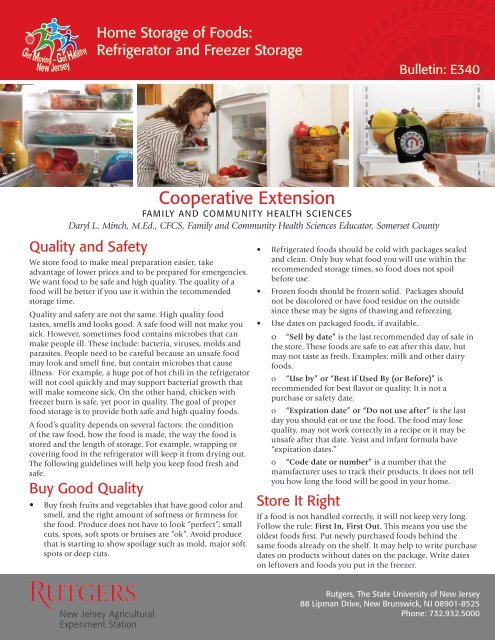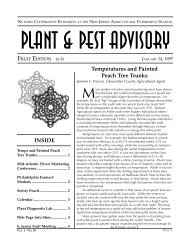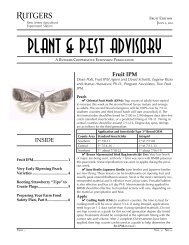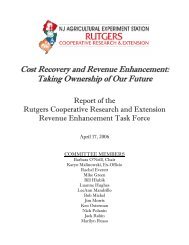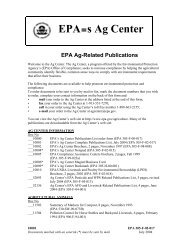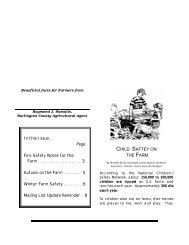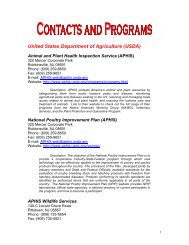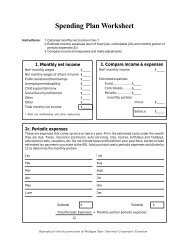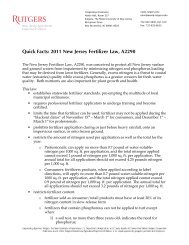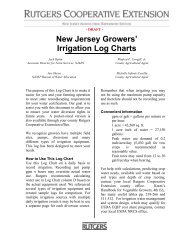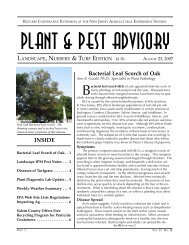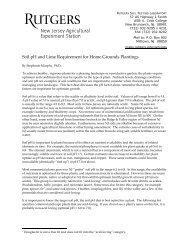Home Storage of Foods: Refrigerator and Freezer Storage - RCE of ...
Home Storage of Foods: Refrigerator and Freezer Storage - RCE of ...
Home Storage of Foods: Refrigerator and Freezer Storage - RCE of ...
Create successful ePaper yourself
Turn your PDF publications into a flip-book with our unique Google optimized e-Paper software.
<strong>Home</strong> <strong>Storage</strong> <strong>of</strong> <strong>Foods</strong>:<br />
<strong>Refrigerator</strong> <strong>and</strong> <strong>Freezer</strong> <strong>Storage</strong><br />
Cooperative Extension<br />
Bulletin: E340<br />
FAMILY AND COMMUNITY HEALTH SCIENCES<br />
Daryl L. Minch, M.Ed., CFCS, Family <strong>and</strong> Community Health Sciences Educator, Somerset County<br />
Quality <strong>and</strong> Safety<br />
We store food to make meal preparation easier, take<br />
advantage <strong>of</strong> lower prices <strong>and</strong> to be prepared for emergencies.<br />
We want food to be safe <strong>and</strong> high quality. The quality <strong>of</strong> a<br />
food will be better if you use it within the recommended<br />
storage time.<br />
Quality <strong>and</strong> safety are not the same. High quality food<br />
tastes, smells <strong>and</strong> looks good. A safe food will not make you<br />
sick. However, sometimes food contains microbes that can<br />
make people ill. These include: bacteria, viruses, molds <strong>and</strong><br />
parasites. People need to be careful because an unsafe food<br />
may look <strong>and</strong> smell fine, but contain microbes that cause<br />
illness. For example, a huge pot <strong>of</strong> hot chili in the refrigerator<br />
will not cool quickly <strong>and</strong> may support bacterial growth that<br />
will make someone sick. On the other h<strong>and</strong>, chicken with<br />
freezer burn is safe, yet poor in quality. The goal <strong>of</strong> proper<br />
food storage is to provide both safe <strong>and</strong> high quality foods.<br />
A food’s quality depends on several factors: the condition<br />
<strong>of</strong> the raw food, how the food is made, the way the food is<br />
stored <strong>and</strong> the length <strong>of</strong> storage. For example, wrapping or<br />
covering food in the refrigerator will keep it from drying out.<br />
The following guidelines will help you keep food fresh <strong>and</strong><br />
safe.<br />
Buy Good Quality<br />
• Buy fresh fruits <strong>and</strong> vegetables that have good color <strong>and</strong><br />
smell, <strong>and</strong> the right amount <strong>of</strong> s<strong>of</strong>tness or firmness for<br />
the food. Produce does not have to look “perfect”; small<br />
cuts, spots, s<strong>of</strong>t spots or bruises are “ok”. Avoid produce<br />
that is starting to show spoilage such as mold, major s<strong>of</strong>t<br />
spots or deep cuts.<br />
• Refrigerated foods should be cold with packages sealed<br />
<strong>and</strong> clean. Only buy what food you will use within the<br />
recommended storage times, so food does not spoil<br />
before use.<br />
• Frozen foods should be frozen solid. Packages should<br />
not be discolored or have food residue on the outside<br />
since these may be signs <strong>of</strong> thawing <strong>and</strong> refreezing.<br />
• Use dates on packaged foods, if available.<br />
o “Sell by date” is the last recommended day <strong>of</strong> sale in<br />
the store. These foods are safe to eat after this date, but<br />
may not taste as fresh. Examples: milk <strong>and</strong> other dairy<br />
foods.<br />
o “Use by” or “Best if Used By (or Before)” is<br />
recommended for best flavor or quality. It is not a<br />
purchase or safety date.<br />
o “Expiration date” or “Do not use after” is the last<br />
day you should eat or use the food. The food may lose<br />
quality, may not work correctly in a recipe or it may be<br />
unsafe after that date. Yeast <strong>and</strong> infant formula have<br />
“expiration dates.”<br />
o “Code date or number” is a number that the<br />
manufacturer uses to track their products. It does not tell<br />
you how long the food will be good in your home.<br />
Store It Right<br />
If a food is not h<strong>and</strong>led correctly, it will not keep very long.<br />
Follow the rule: First In, First Out. This means you use the<br />
oldest foods first. Put newly purchased foods behind the<br />
same foods already on the shelf. It may help to write purchase<br />
dates on products without dates on the package. Write dates<br />
on leftovers <strong>and</strong> foods you put in the freezer.<br />
Rutgers, The State University <strong>of</strong> New Jersey<br />
88 Lipman Drive, New Brunswick, NJ 08901-8525<br />
Phone: 732.932.5000
<strong>Refrigerator</strong>:<br />
• Keep a thermometer in the refrigerator <strong>and</strong> keep the<br />
temperature at 35° F to 40° F.<br />
• Open the door as little as possible. Every time the door<br />
opens, warm air enters which can raise the temperature<br />
<strong>of</strong> the refrigerator <strong>and</strong> lower food quality. It also increases<br />
electricity costs.<br />
• Wrap or cover food to prevent the loss <strong>of</strong> flavor <strong>and</strong><br />
moisture. It also prevents the mixing <strong>of</strong> flavors <strong>and</strong> odors,<br />
so your milk does not taste like onion or fish.<br />
• Place raw meat, poultry, or fish on a plate or tray <strong>and</strong> put<br />
on the lowest shelf in the refrigerator. This will keep the<br />
food from dripping onto <strong>and</strong> contaminating other foods.<br />
• Wrap or package leftovers to keep them from leaking <strong>and</strong><br />
drying out. Plastic bags <strong>and</strong> containers work well. Most<br />
leftovers are best used within 3 to 4 days.<br />
<strong>Freezer</strong>:<br />
• Keep a thermometer in the freezer <strong>and</strong> keep the<br />
temperature at or below 0°F. If the temperature is<br />
higher than 0°F, the food will not keep its good quality<br />
as long.<br />
• Keep your freezer full with food or add ice. A full freezer<br />
holds its temperature better.<br />
• Open the door as little as possible. Every time the door<br />
opens, warm air enters which can raise the temperature<br />
<strong>of</strong> the freezer <strong>and</strong> lower food quality. It also increases<br />
electricity costs.<br />
• Wrap foods in moisture-pro<strong>of</strong>, freezer-weight wrap or<br />
use plastic containers. Examples <strong>of</strong> wrap are plastic<br />
freezer bags, heavy foil, <strong>and</strong> freezer paper. Label <strong>and</strong> date<br />
packages.<br />
• Keep a list <strong>of</strong> foods in the freezer. This will help with<br />
meal planning, knowing what to purchase, <strong>and</strong> minimize<br />
searching for food.<br />
E340 - <strong>Refrigerator</strong> & <strong>Freezer</strong> <strong>Storage</strong><br />
• <strong>Freezer</strong> burn on a food looks like a dry spot <strong>and</strong> food may<br />
be white or gray in color. It is the result <strong>of</strong> cold air getting<br />
to the food’s surface <strong>and</strong> drying the food out. <strong>Freezer</strong><br />
burn will not make you sick, but the food will be dry <strong>and</strong><br />
tough. Wrapping food tightly <strong>and</strong> sealing out air will help<br />
protect the food.<br />
• Ice crystals or frost may appear on food or in packaging<br />
during storage in the freezer. This is moisture evaporation<br />
from the food <strong>and</strong> will result in a dried out product. It<br />
is more common in baked goods, fruit <strong>and</strong> vegetables.<br />
Wrapping food tightly, sealing out air <strong>and</strong> following<br />
storage guidelines will help minimize moisture loss.<br />
• Frozen food stored beyond the recommended time will<br />
be safe to eat. However, the food may be dried out, tough<br />
<strong>and</strong> flavor or texture may change.<br />
Keep It Clean<br />
Since bacteria can get into food during food h<strong>and</strong>ling, keep<br />
everything – h<strong>and</strong>s, counter tops, dishes, utensils, <strong>and</strong> the<br />
refrigerator <strong>and</strong> freezer - clean. Wash your h<strong>and</strong>s with soap<br />
<strong>and</strong> warm water for at least 20 seconds before putting away<br />
groceries, preparing food, or putting away leftovers. This will<br />
greatly reduce the risk spreading bacteria <strong>and</strong> viruses <strong>and</strong><br />
getting sick.<br />
For More Food Safety Information:<br />
Websites:<br />
Rutgers Cooperative Extension: njaes.rutgers.edu<br />
FightBAC!: www.fightbac.org<br />
Food Safety <strong>and</strong> Inspection Service : fsis.usda.gov<br />
General: www.FoodSafety.gov<br />
Telephone:<br />
Call the county Cooperative Extension <strong>of</strong>fice or your county<br />
government. Offices are listed on the NJAES website.<br />
USDA Meat & Poultry Hotline: Weekdays 10 to 4 PM EST,<br />
1-800-535-4555<br />
Food <strong>and</strong> Drug Administration Food Information Line:<br />
1-888-723-3366
Food <strong>Refrigerator</strong>: 35° - 40°F<br />
(*=not recommended;<br />
NA=not applicable)<br />
DAIRY<br />
<strong>Freezer</strong>: 0°F<br />
(*=not recommended;<br />
NA=not applicable)<br />
Notes<br />
Buttermilk 1-2 weeks 3 months<br />
Butter or margarine 1-3 months 6-9 months Read labels, some<br />
margarines do not<br />
freeze well<br />
Condensed & evaporated 4-5 days *<br />
milk (opened)<br />
Cottage cheese, Ricotta 1 week *<br />
Cream - heavy, whipping, 10 days *<br />
half & half, light<br />
(unwhipped)<br />
Cream - whipped in<br />
3 months *<br />
aerosol can<br />
Milk 1 week 1 month<br />
Cheese (hard) - cheddar,<br />
Montery Jack, swiss,block<br />
Parmesan, etc.<br />
Cheese - grated or<br />
shredded<br />
Cheese - processed food<br />
products<br />
6 months unopened &<br />
3-4 months opened<br />
6 months<br />
1 month 3-4 months<br />
3-4 weeks 4 months<br />
Cheese - cream (opened) 2 weeks *<br />
Cheese spreads &<br />
3-4 weeks *<br />
processed cheese<br />
Ice cream, frozen yogurt * 2-4 months<br />
Sour cream 1-3 weeks *<br />
Yogurt 7-14 days 1-2 months Check package date<br />
BEEF, LAMB, PORK, VEAL<br />
Chops 3-5 days 4-6 months<br />
Pre-stuffed uncooked chops 1 day *<br />
Roasts 3-5 days 4-12 months<br />
Steak 3-5 days 6-12 months<br />
Stew meat 1-2 days 3-4 months<br />
Ground meat 1-2 days 3-4 months<br />
Sausage, smoked -<br />
2-3 weeks 1-2 months<br />
pepperoni, jerky<br />
Sausage - raw from chicken, 1-2 days 1-2 months<br />
turkey, beef or pork<br />
Sausage - summer (labeled<br />
"keep refrigerated"<br />
E340- <strong>Refrigerator</strong> & <strong>Freezer</strong> <strong>Storage</strong><br />
unopened - 3 months;<br />
opened 3 weeks<br />
1-2 months
Food <strong>Refrigerator</strong>: 35° - 40°F<br />
(*=not recommended;<br />
NA=not applicable)<br />
<strong>Freezer</strong>: 0°F<br />
(*=not recommended;<br />
NA=not applicable)<br />
Notes<br />
BEEF, LAMB, PORK, VEAL<br />
(cont’d)<br />
Smoked breakfast links or patties 7 days 1-2 months<br />
Whole ham (fully cooked) 7 days 1-2 months<br />
Half ham (fully cooked) 3-5 days 1-2 months<br />
Sliced ham (fully cooked) 3-4 days 1-2 months<br />
Canned ham - labeled<br />
6-9 months unopened & 1-2 months Do not freeze<br />
"keep refrigerated"<br />
3-5 days opened<br />
in can<br />
Bacon 7 days 1 month<br />
Corned beef 5-7 days (in pouch with<br />
juices)<br />
1 month (drained)<br />
Hotdogs 2 weeks unopened &<br />
1 week opened<br />
1-2 months<br />
OTHER MEATS<br />
Bison (Buffalo) Ground or stew meat -<br />
2 days; larger cuts -<br />
3-5 days<br />
Ground or cut-up -<br />
4 months; Chops, steak &<br />
roasts - 6-9 months<br />
Other game - Elk, rabbit 3-5 days 6-9 months Less time for ground,<br />
stew meat or chops.<br />
Longer time for roast.<br />
Smoked game, vacuum-sealed Sealed - 2 weeks (or 1 week<br />
after "Use-By" date); opened<br />
7 days<br />
1-2 months<br />
Variety Meats - heart, liver, kidney,<br />
tongue, etc.<br />
1-2 days 3-6 months<br />
Venison - Roasts, steaks, chops 3-5 days 9-12 months Less time for ground,<br />
stew meat or chops.<br />
Longer time for roast.<br />
DELI & VACUUM-PACKED MEAT PRODUCTS<br />
Lunch meats (vacuum packed &<br />
unopened)<br />
2 weeks 1-2 months<br />
Lunch meats (vacuum packed or<br />
fresh cut, opened)<br />
3-5 days 1-2 months<br />
COOKED, LEFTOVER MEAT<br />
Meat & meat casseroles 3-4 days 2-3 months<br />
Gravy & meat broth 3-4 days 2-3 months<br />
Soups & stews 3-4 days 2-3 months<br />
E340 - <strong>Refrigerator</strong> & <strong>Freezer</strong> <strong>Storage</strong>
Food <strong>Refrigerator</strong>: 35° - 40°F<br />
(*=not recommended;<br />
NA=not applicable)<br />
POULTRY PRODUCTS<br />
Chicken or turkey, whole 1-2 days 1 year<br />
Chicken or turkey, pieces 1-2 days 9 months<br />
Giblets 1-2 days 3-4 months<br />
Ground turkey & chicken 1-2 days 3-4 months<br />
Duck, whole 1 day 6 months<br />
Game birds - goose,<br />
1-2 days 6-12 months<br />
pheasant, quail<br />
COOKED, LEFTOVER POULTRY<br />
Fried chicken 3-4 days 4 months<br />
Cooked casseroles 3-4 days 4-6 months<br />
Plain pieces 3-4 days 4 months<br />
Pieces with broth/gravy 3-4 days 6 months<br />
Nuggets or patties 3-4 days 1-3 months<br />
EGGS<br />
E340 - <strong>Refrigerator</strong> & <strong>Freezer</strong> <strong>Storage</strong><br />
<strong>Freezer</strong>: 0°F<br />
(*=not recommended;<br />
NA=not applicable)<br />
Fresh in shell 3-5 weeks *<br />
Raw yolks, whites 2-4 days 1 year<br />
Hardcooked 1 week *<br />
Liquid pasteurized eggs or 10 days unopened & unopened - 1 year; opened not<br />
egg substitute<br />
3 days opened<br />
recommended<br />
Eggnog commercial 3-5 days;<br />
homemade 2-4 days<br />
FISH<br />
Fresh finfish<br />
Lean fish – cod, flounder,<br />
haddock, halibut, pollack,<br />
ocean perch, sea trout & rock<br />
fish<br />
Fatty fish – bluefish,<br />
mackerel, mullet, smelts,<br />
salmon, swordfish, trout,<br />
tuna, etc.<br />
3 days 6-8 months<br />
3 days 2-3 months<br />
commercial 6 months,<br />
homemade not recommended<br />
Notes<br />
Keep finfish &<br />
shellfish on ice in the<br />
refrigerator
Food <strong>Refrigerator</strong>: 35°- 40°F<br />
(*=not recommended;<br />
NA=not applicable)<br />
Fresh or live shellfish<br />
Live crabs & lobster 1-2 days *<br />
Live clams, mussels & oysters 4-5 days *<br />
Shrimp, scallops, crawfish,<br />
squid<br />
4 days 5 months<br />
Smoked fish<br />
FRUITS<br />
14 days 2 months<br />
<strong>Freezer</strong>: 0°F<br />
(*=not recommended;<br />
NA=not applicable)<br />
Apples 6 weeks 12 months, cooked<br />
Apricots 3-4 days 12 months<br />
Notes<br />
Contact Family &<br />
Community Health Sciences<br />
for specific directions on<br />
how to freeze fruit.<br />
Bananas * 12 months Refrigerating bananas will<br />
cause the skin, but not the<br />
flesh to darken.<br />
Berries 1-2 days 12 months<br />
Cherries 1 week 12 months<br />
Grapes 1 week 1 month<br />
Citrus: grapefruit, lemons,<br />
limes & oranges<br />
2-8 weeks 3-4 months<br />
Guavas 1-2 days 12 months<br />
Kiwis (Chinese<br />
gooseberry)<br />
1-2 days 12 months<br />
Mangos 2-3 days 12 months<br />
Melons 3-4 days 12 months<br />
Papayas 1 week 12 months<br />
Peaches & nectarines 3-4 days 12 months<br />
Pears 3-4 days 12 months<br />
Pineapples 3-5 days 12 months<br />
Plantains * 12 months<br />
Plums 3 days 12 months<br />
Pomegranate 3 months whole 3 months - whole seeds<br />
Rhubarb<br />
FRUIT JUICES<br />
1 week 12 months<br />
Apple or Cider 6 Days NA<br />
Bottled or canned (opened) 3-4 Days NA<br />
Concentrate 6 Days 1 Year<br />
E340 - <strong>Refrigerator</strong> & <strong>Freezer</strong> <strong>Storage</strong>
Food <strong>Refrigerator</strong>: 35° - 40°F<br />
(*=not recommended;<br />
NA=not applicable)<br />
VEGETABLES<br />
<strong>Freezer</strong>: 0°F<br />
(*=not recommended;<br />
NA=not applicable)<br />
Notes<br />
Contact Family &<br />
Community Health Sciences<br />
for specific directions on<br />
how to freeze vegetables.<br />
Asparagus 3-4 days 12 months<br />
Avocados 3-5 days *<br />
Beans, shell - lima, fava, soy 2 -3 days in pod &<br />
12 months<br />
1-2 days shelled<br />
Beets 3 weeks 12 months<br />
Bok Choy 1-3 days 12 months<br />
Broccoli 4 days 12 months<br />
Brussel Sprouts 3-5 days 12 months<br />
Cabbage - green, red, 1-2 weeks 1 Year Freeze for cooked dishes<br />
napa, savoy<br />
only, otherwise soggy<br />
Carrots 2 weeks 12 months<br />
Cauliflower 5 days 12 months<br />
Celery 1-2 weeks 10-12 months<br />
Chilies & hot peppers 2 weeks 12 months<br />
Cilantro 1-3 days * St<strong>and</strong> roots or stems in<br />
water & cover loosely with<br />
plastic bag in refrigerator<br />
Corn 1-2 days On cob - 8-10 months; Use immediately for best<br />
kernals - 12 months flavor<br />
Cucumbers 1 week *<br />
Eggplant 3-4 days 12 months<br />
Green beans 3-5 days 8 months<br />
Greens – spinach, collards, 1-2 days 10-12 months<br />
swiss chard, kale, mustard,<br />
etc.<br />
Jerusalem artichokes 1 week 12 months<br />
Jicama 2-3 weeks, uncut 12 months<br />
Kohlrabi - leaves 2-3 days 12 months<br />
Kohlrabi - stem 1 week 12 months<br />
Leeks 1 week 3-6 months<br />
Mushrooms 3-7 days 10-12 months Unopened, packaged<br />
mushrooms keep longest<br />
Onions, green - scallions 1-2 weeks 3-6 months<br />
Okra 3-4 days 12 months<br />
Parsley 2-3 days *<br />
E340 - <strong>Refrigerator</strong> & <strong>Freezer</strong> <strong>Storage</strong>
Food <strong>Refrigerator</strong>: 35° - 40°F<br />
(*=not recommended;<br />
NA=not applicable)<br />
VEGETABLES (cont’d)<br />
<strong>Freezer</strong>: 0°F<br />
(*=not recommended;<br />
NA=not applicable)<br />
Notes<br />
Peas 1-2 days 12 months use immediately for best<br />
flavor<br />
Peppers - green, red, yellow 1 week 6-8 months<br />
Radishes - red, Diakon 2 weeks *<br />
Squash, hard * 12 months<br />
Squash, summer - yellow 4-5 days 12 months<br />
crookneck, zucchine<br />
Tomatillos 1 month 12 months<br />
Tomatoes 2-3 days 12 months For best flavor do not<br />
refrigerate<br />
Yuca (Cassava) * 12 months<br />
BAKED PRODUCTS<br />
Breads<br />
Bread, yeast * 2-3 months<br />
Muffins * 2-4 months<br />
Quick breads * 2-4 months<br />
Pancakes & waffles * 2-4 months<br />
Rolls, yeast * 2-3 months<br />
Cakes<br />
Angel, Chiffon & Sponge * 6 months<br />
Cheesecake 7 days 4-6 months<br />
Fruitcake * 12 months<br />
Layer cake Plain, buttercream icing<br />
- not necessary; custard,<br />
cream or whipped cream<br />
filling or icing - refrigerate<br />
Plain - 3 months<br />
Iced - 6 months<br />
Cookies * baked - 6 months, unbaked<br />
Pies<br />
dough - 4 months<br />
Chiffon & custard 3-4 days *<br />
Fruit 1-2 days 6-8 months<br />
Pumpkin 3-4 days baked 1-2 months<br />
Unbaked fruit * 4 months<br />
Quiche 3-4 days baked 1-2 months<br />
E340 - <strong>Refrigerator</strong> & <strong>Freezer</strong> <strong>Storage</strong><br />
In general, do not<br />
refrigerate. Breads stale<br />
faster in the refrigerator.<br />
However, refrigeration<br />
may reduce mold growth<br />
if home is hot & humid.
Food <strong>Refrigerator</strong>: 35° - 40°F<br />
(*=not recommended;<br />
NA=not applicable)<br />
BABY FOOD<br />
Liquid<br />
<strong>Freezer</strong>: 0°F<br />
(*=not recommended;<br />
NA=not applicable)<br />
Expressed breast milk 3-5 days 5° F - 2 weeks; 0°F 3-6<br />
months; -4° - 6-12 months<br />
Formula 2 days *<br />
Solids (open or freshly made)<br />
Strained fruits & 2-3 days 6-8 months<br />
vegetables<br />
Strained meat & eggs 1 day 1-2 months<br />
Strained meat/vegetable 1-2 days 6-8 months<br />
combination<br />
<strong>Home</strong>made baby foods 1-2 days 3-4 months<br />
CONDIMENTS<br />
Ketchup & Barbecue 8-12 months *<br />
sauce (opened)<br />
Mayonnaise<br />
2 months *<br />
(commercial, opened)<br />
Mustard (opened) 8-12 months *<br />
Salad dressing - bottled 4 months *<br />
(opened)<br />
MISCELLANEOUS<br />
Chestnuts 6 months *<br />
Notes<br />
<strong>Storage</strong> time depends on<br />
temperature <strong>and</strong> conditions.<br />
Breast milk has natural<br />
antibacterial qualities & may be<br />
stored on a counter at 60°-85°F<br />
for 3-4 hours. See reference list<br />
for more information.<br />
Guacamole <strong>Home</strong>meade - 1-3 days; 6 months<br />
commercial - 5-7 days<br />
Hummus <strong>Home</strong>made - 2-7 days; *<br />
commercial - 5-7 days<br />
Nuts 6+ months 1 year May store in cool & dry cabinet<br />
for 3-4 months. Refrigerate or<br />
freeze for longer storage.<br />
Pasta, fresh 1 week 1 month<br />
Pizza 3-4 days 1-2 months<br />
Salads - chicken, turkey, 3-5 days *<br />
ham, tuna & pasta<br />
Syrups - maple or 6-8 months *<br />
panckake<br />
T<strong>of</strong>u 1 week 5 months Store in water in refrigerator &<br />
replace water daily.<br />
E340 - <strong>Refrigerator</strong> & <strong>Freezer</strong> <strong>Storage</strong>
<strong>Foods</strong> that do not freeze well<br />
Because <strong>of</strong> flavor changes<br />
• Garlic (uncooked)<br />
• Onion (raw; better cooked or as ingredient)<br />
• Salt substitutes (not sodium chloride)<br />
• Spices – clove, sage (flavor is stronger or bitter)<br />
• Vanilla, artifical flavor (not real vanilla)<br />
Because <strong>of</strong> texture changes<br />
• Cake icing - s<strong>of</strong>t or boiled (butter cream freezes well)<br />
• Cream sauces<br />
• Custard or cream filling<br />
• Egg whites (cooked) & meringue<br />
• Fried foods (homemade)<br />
• Gelatin<br />
• Mayonnaise or salad dressing<br />
• Lettuce<br />
• Pasta (cooked, unsauced)<br />
• Potatoes<br />
© 2012 Rutgers, The State University <strong>of</strong> New Jersey. All rights reserved.<br />
For a comprehensive list <strong>of</strong> our publications visit www.njaes.rutgers.edu June 2012<br />
Cooperating Agencies: Rutgers, The State University <strong>of</strong> New Jersey, U.S. Department <strong>of</strong> Agriculture, <strong>and</strong> County Boards <strong>of</strong> Chosen Freeholders. Rutgers Cooperative Extension, a unit <strong>of</strong> the<br />
Rutgers New Jersey Agricultural Experiment Station, is an equal opportunity program provider <strong>and</strong> employer.<br />
Rutgers, The State University <strong>of</strong> New Jersey<br />
88 Lipman Drive, New Brunswick, NJ 08901-8525<br />
Phone: 732.932.5000


